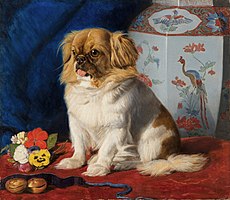|
Looty (dog)
Looty or Lootie was a female Pekingese dog acquired by Captain John Hart Dunne during the looting of the Old Summer Palace (near Beijing) in October of 1860. He presented her to Queen Victoria for the Royal Collection of Dogs, who named her Looty or Lootie in reference to how she was acquired. Looty may have been the first Pekingese dog to arrive in England. AcquisitionDuring the Second Opium War in October 1860, British and French forces looted the Old Summer Palace (Yuanmingyuan) near Peking (modern Beijing). British Captain John Hart Dunne came across a small Pekingese dog. He later recorded the event in his diary:
Dunne brought it back to England by sea, letting it sleep in his forage cap.[2] It is said to have been the first Pekingese to survive the voyage and arrive in Britain, however this is disputed.[3][2][4] Life in EnglandDunne presented the dog to Queen Victoria in 1861, writing that:
Her Majesty was graciously pleased to accept the dog. She named it Looty or Lootie in reference to how it was acquired.[2] Looty was "considered by every one who has seen it the smallest and by far the most beautiful little animal that has appeared in this country."[6] Her integration into the Royal household was not without problems. Dunne had given instruction that she was a fastidious and delicate eater, and would accept only rice and chicken. These were commonplace in China and the Royal Court there. However the British instead offered her their standard dog food, primarily beef and offal. These were ingredients that the Chinese court would have regarded with horror and she would not have recognised as food.[2] Following Keyl's painting of her portrait, Looty was taken to the main kennels at Windsor Castle and lived there for the rest of its life.[3][5] There, she became more of a curiosity than the pet which Dunne had hoped for. The Queen herself took little account of her gift, having other more favoured dogs which she kept with her.[7] In 1912, Harper's Weekly described the dog:
Looty died at Windsor Castle on 2 March 1872.[5] Unlike many of the queen's dogs, her grave is unmarked.[9] DepictionsQueen Victoria commissioned a painting of the dog by Friedrich Wilhelm Keyl in 1861, a copy of which was given to Captain Dunne.[3] William Bambridge captured a few photographs of the dog in 1865, including one of Looty asleep on an ornate chair, which remains in the Royal Collection Trust.[10] Another showed Looty lying on a footstool.[11] Historic significanceModern critics have described Looty the dog as symbolic of British imperialism. At the time, naming it "Looty" was seen as appropriate to its status.[6] The flippancy in choosing this name is symptomatic of how normalized and socially acceptable the looting of foreign nations was still considered at the time.[12][13] See alsoReferencesNotesCitations
Bibliography
|
||||||||||||||||||
Portal di Ensiklopedia Dunia
